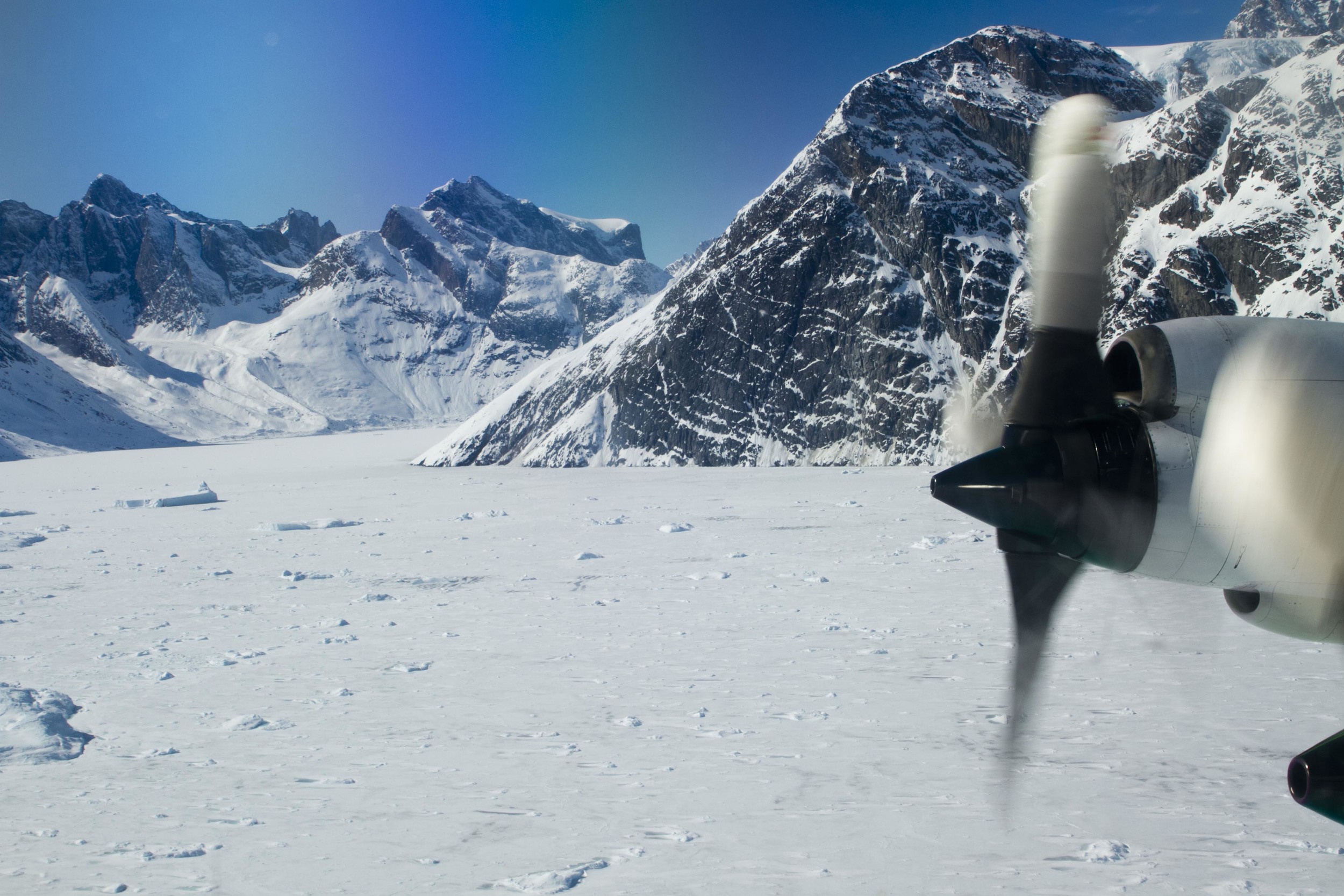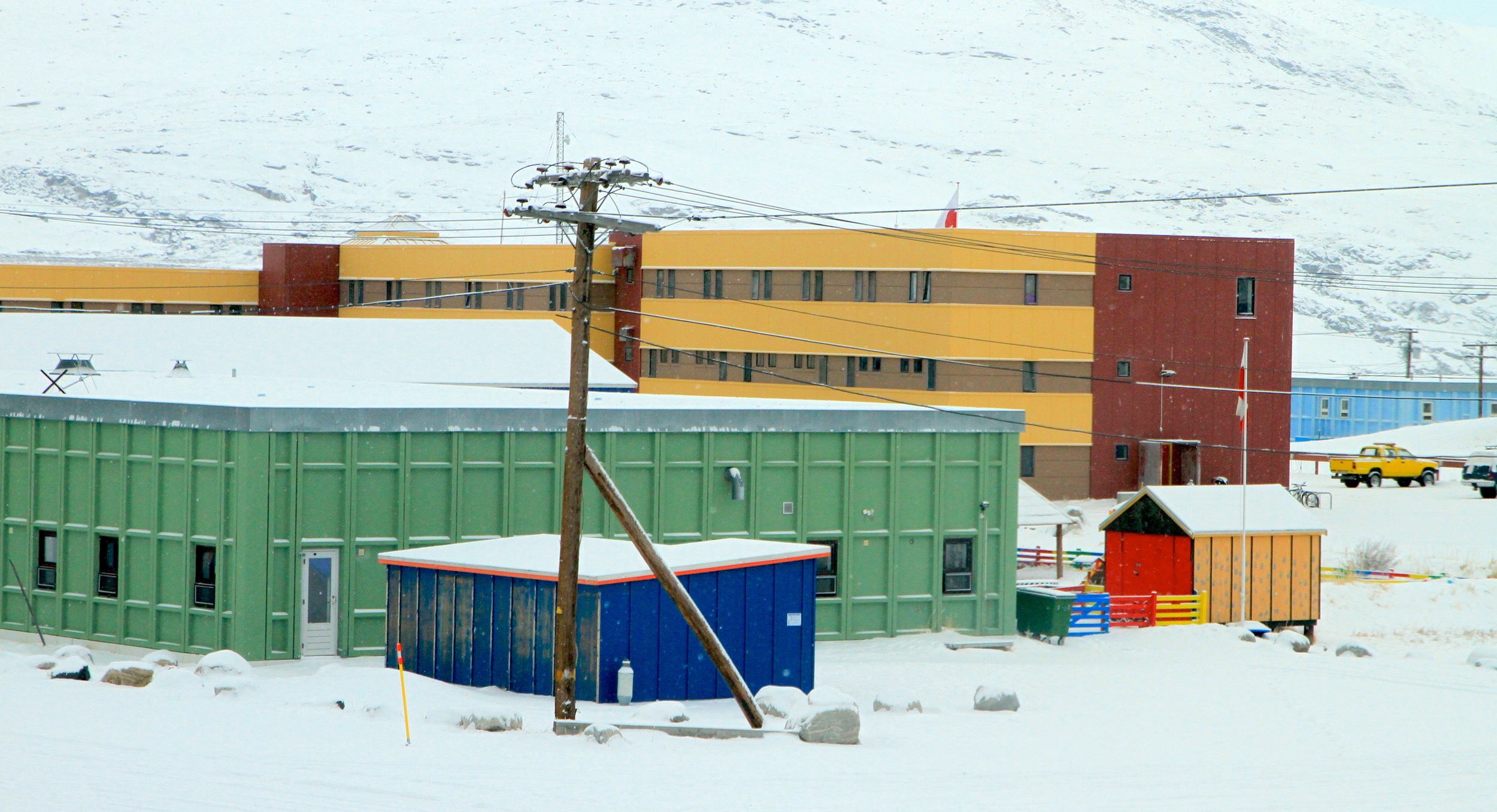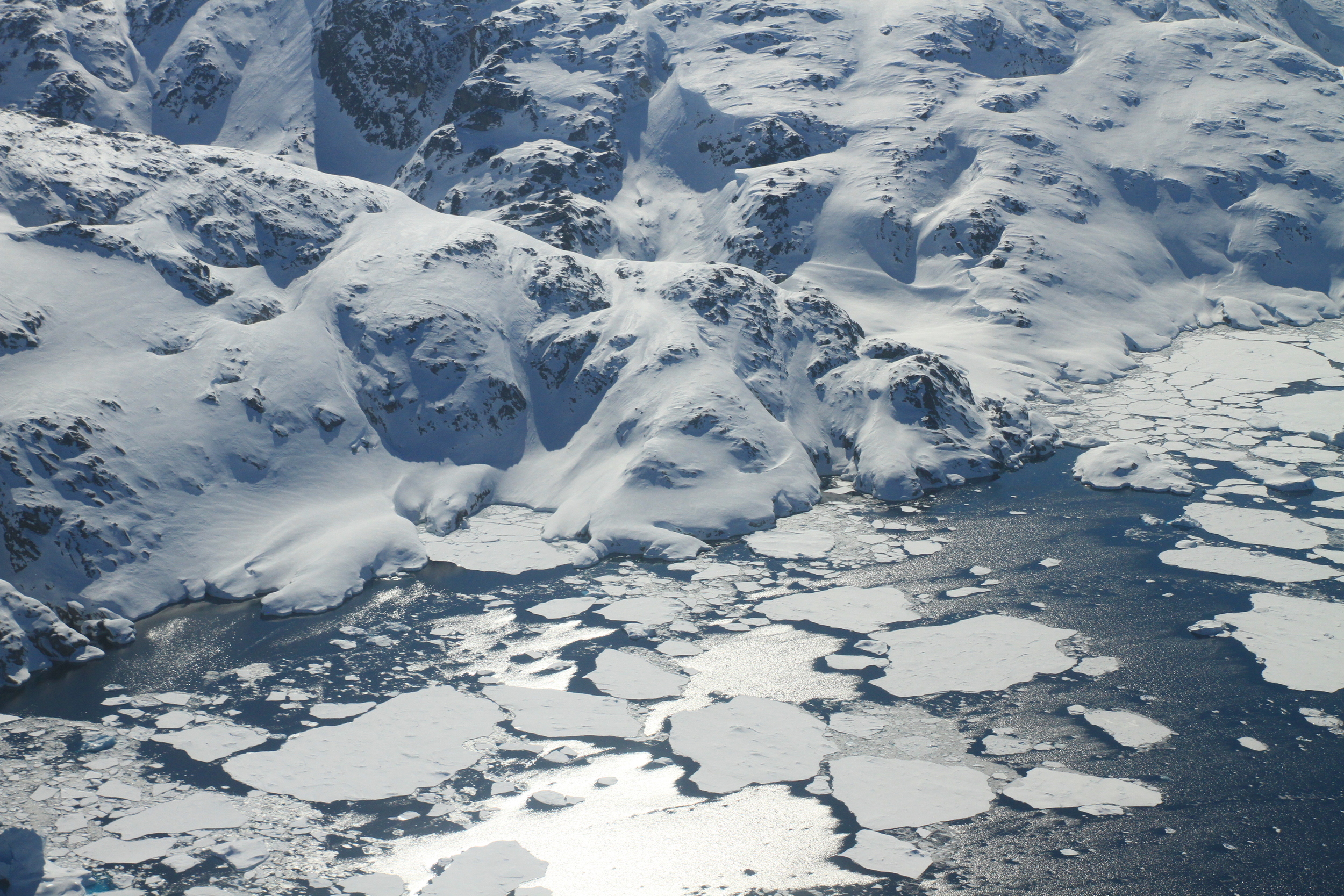This constitutes a main road just outside of Kangerlussuaq, Greenland. If you don't like where it's going, you might be out of luck, because there aren't many alternatives.
In Kangerlussuaq, Greenland, ice and stone hold up the sky; there are no trees. What few paved roads actually connect the handful of brightly painted buildings quickly come to harsh ends at washboard gravel. It’s as if aging asphalt only adheres to the Earth as far as weary laborers are obliged to spread it around before they run inside to get warm. There are practically no destinations for these roads to carry a traveller. Bumpy, jarring rides over them become existential journeys, sojourns that rattle bones through ever-changing terrain without the promise of much more. Visitors to Greenland must find a way to make something out of whatever they have wherever they are; they shouldn’t expect to find comfort anywhere they drive. The land may be vast, but there really isn’t anywhere to go.
Yes, it's cold. Of course, it’s cold. Moisture hardly moves. Dry air abrades exposed skin, pulling heat from the body like thorns, like splinters. The eye constantly roams the horizon for traces of life-giving green, for shreds of hope. It finds none. There is stone. There is ice. In the sunny apricot of spring’s brief afternoon light, half-hearted rivulets of melting water mix with crushed rock and dirt to congeal into an endless slurry of muck. At nightfall those trickles turn hard again and threaten to twist unwary ankles.
“The pin on this map shows the location of the KISS science facility, right on the edge of the runway in Kangerlussuaq, Greenland. The dark grey mass along the bottom and extending off to the right of the map is a frozen river of glacial runoff, a raging beast in summer, but frozen solid most of the rest of the year.”
Ironically there is technology here, imported, but you need to know where to look. Airplanes and lasers and lenses and microprocessors: at the Kangerlussuaq International Science Support facility (KISS) researchers from distant places hunker down and set up experimental enterprises of all types. But the technology and it's handlers only rent space. Greenland is not the province of modernity, and KISS is only a hardscrabble outpost.
Logistics and schedules and data consume most waking hours of the researchers no matter what their stripe. In free moments it’s a push just to pursue pairs of clean socks, to eat something beyond pre-processed foods from plastic wrappers, to remember music, espresso, and growing things. Fresh vegetables barely make it to the local grocery in substantial numbers. A bag of carrots glows in the produce bin like buried treasure pulled from an enchanted archaeological dig.
The research done at KISS matters to everyone on Earth. It matters mightily, in fact, even if that vast majority don’t understand what it means or even know it’s happening at all. But like surgery for a gallstone, its vital importance doesn’t necessarily mean everyone getting it done is having a good time.
Nonetheless, where you find people living for more than a day or two in a group you find artistic expressions of one type of another, even if traditional artists are hard to find. Here on the edge of a massive ice sheet two miles thick that truism holds. In the more ordinary spaces of first-world life, we expect creativity to express itself through more familiar tropes and tools. Far away from those rhythms and sensations, however, creativity expresses itself in more muted colors.
There’s the requisite guitar player, sure. There’s the fellow who manages to make magic in the kitchen no matter how sparse his list of ingredients. There’s the Ph.D. scientist who’s got a terrific photographic eye, with a special affinity for icebergs and cloud shadows. But the real art here, the pièce de résistance, is the clever way the experts collectively manage to coax science results out of rough assignments, cold circuits, and hot-blooded hard work.
This crowd is more an engineering corp than a team of scientists. As such, it’s a crowd less wont to scratch their navel and wonder than to figure out a better way to make itches go away altogether. There’s a team from the University of Indiana drilling for samples of methanogenic bacteria in deep ice, studying the ancient past. Then there’s the NASA team with whom I’m traveling, flying at low altitude over endless ice to study the ferociously changing present.
On NASA’s retrofitted aircraft, a former cold war submarine hunter called a P3 Orion, the team finds inventive ways to do ordinary and extraordinary things. For example, to warm up their gear each morning after it sits through sub-zero nights on the tarmac, the team blithely uses cheap hand-held hair driers. To combat the relentless fatigue of long flight days, early morning musters, and late night engineering reviews, the crew takes turns sacking out mid-flight on the folded engine covers, piled like spent parachutes inside the airplane’s hard, cold cabin.
The team’s resident artist (me, in this case) is clearly a tropical mammal stuck in a polar zone. Though polite, the engineering team doesn’t really understand what makes me tick and to some extent the feeling is mutual. Nonetheless we find commonalities and boundaries and ultimately intense mutual respect. Tasked with translating the tough science and engineering of the mission to a wide, non-technical audience, my job requires a willingness to learn everything and do everything, from setting up and maintaining a mobile video production area to shooting, writing, editing, and hosting a range of programming. It’s one part MacGyver, one part National Geographic. Hours disappear into ferocious jags of media multi-tasking. If the computer is tied up processing footage from the night before, I’m out with my camera shooting new footage for this afternoon. If the light isn’t right for the b-roll I need today, I’m getting a jump on script materials for the next day, or scouting locations for future shoots. If I’m on the airplane for an eight hour flight over the endless Greenland ice sheet, the trick is to keep the camera steady without hurling my guts all over the electronics as the plane jinks around like a wind-tossed kite.
In front of the engineering team, I demand one thing of myself above all else: no complaining. The engineers are just as busy, and without their efforts there’s no reason to be here in the first place.
In the seemingly endless month above the Arctic Circle the greatest creative enterprise turn out to be finding solutions for maintaining a sense of humor and overall sanity. If there is art without art, it exists in the fight not to recede into a bitter lump in the corner. Over the many weeks on this deployment, however, I start to become aware of something substantial like a slow motion dawn: many people on the trip do not share my silent cri de coeur. The engineers seem to take their days as expected, as ordinary, as the stuff of a career. Where I find monotony and grind, they find consistency. Where I discovery epiphany, they brush aside as ordinary. Where I feel victory, they yawn as if it were just another day at the office. That’s not to say they’re thrilled to continue endless days over the ice, but it is to recognize that not everyone requires the same inputs to feel complete. Even in more ordinary spaces, most of us live in worlds that ultimately inhibit art and it’s sensual attendants—perhaps not as dramatically as a research mission to the Arctic, but still. Daily traffic jams and applications for medical insurance and piles of laundry do not instill poetic passions. Yet somehow art endures. It endures because the creative spark is ultimately what keeps us going. On assignment in Greenland the forces of that inhibit creative souls from shining simply constrict in different ways than they do back in more carpeted, heated comforts. Where something constricts, there are inevitably cracks where the center mass squeezes out, like icing pressed out between layer cakes.
The deepest insight here at the edge of the world is that even at the extremes creative souls still stir. With almost no time for anything but work and essential labors necessary to maintain life and limb, literature and accomplished music and modern dance will not grow. It’s a simple statement and it’s true, just like tomato plants to not yield fruit in the desert. But here and there, in nuanced ways, I see expressions of individual expression, of ways to remake the world. The Spanish speaking radar expert from a midwestern university’s graduate program, flying with us on the NASA plane, arranges wildflower stickers on the back of his laptop—actual, tangible, paper pictures physically attached to the back of his electronic portal into The Matrix. When I ask him about it he tells me that they remind him of the town were he grew up as a kid in Coahuila, Mexico.
The real discovery here on Greenland’s ice sheet is the revitalized charge to notice similarly nuanced expressions back it the jangled world far, far away. Creative expressions have no other purpose than to remake our existences day to day.









